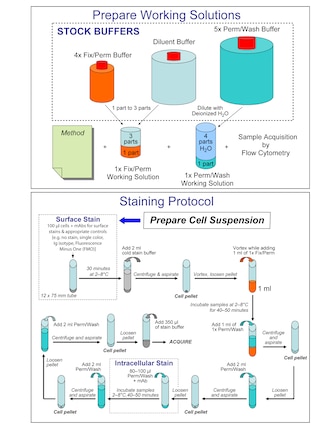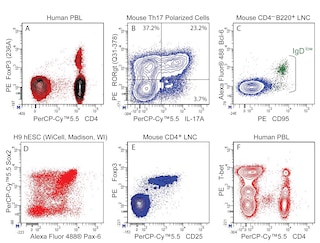-
Your selected country is
Middle East / Africa
- Change country/language
Old Browser
This page has been recently translated and is available in French now.
Looks like you're visiting us from {countryName}.
Would you like to stay on the current country site or be switched to your country?




Flow cytometric analysis of human RORγt expression in human SR cells. Cells from the human SR cell line (ATCC CRL-2262) were fixed and permeabilized using the BD Pharmingen™ Transcription Factor Buffer Set (Cat. No. 562574/562725) and then stained with either BD Horizon™ BV421 Mouse IgG2b, κ Isotype Control (Cat. No. 562748; dashed line histogram) or BD Horizon™ BV421 Mouse Anti-Human RORγt antibody (Cat. No. 563282; solid line histogram). The fluorescence histograms were derived from gated events with the forward and side light-scatter characteristics of intact cells. Flow cytometric analysis was performed using a BD™ LSR II Flow Cytometer System.


BD Horizon™ BV421 Mouse Anti-Human RORγt

Regulatory Status Legend
Any use of products other than the permitted use without the express written authorization of Becton, Dickinson and Company is strictly prohibited.
Preparation And Storage
Product Notices
- This reagent has been pre-diluted for use at the recommended Volume per Test. We typically use 1 × 10^6 cells in a 100-µl experimental sample (a test).
- An isotype control should be used at the same concentration as the antibody of interest.
- Caution: Sodium azide yields highly toxic hydrazoic acid under acidic conditions. Dilute azide compounds in running water before discarding to avoid accumulation of potentially explosive deposits in plumbing.
- Source of all serum proteins is from USDA inspected abattoirs located in the United States.
- Pacific Blue™ is a trademark of Molecular Probes, Inc., Eugene, OR.
- Brilliant Violet™ 421 is a trademark of Sirigen.
- For fluorochrome spectra and suitable instrument settings, please refer to our Multicolor Flow Cytometry web page at www.bdbiosciences.com/colors.
- Please refer to www.bdbiosciences.com/us/s/resources for technical protocols.
Companion Products





The Q21-559 monoclonal antibody recognizes ROR gamma t (RORγt), an isoform of ROR gamma (RORγ). RORγt is a DNA-binding transcription factor that is encoded by the RORC (RAR-related orphan receptor C) gene. It belongs to the ROR/RZR orphan nuclear receptor family. Two protein isoforms are produced from the RORC gene by alternative splicing: RORγ or RORγt. The RORγ isoform is expressed in many tissues, including thymus, lung, liver, kidney, muscle, and brown fat. However the tissue distribution of the second isoform RORγt is highly restricted to the thymus where it is expressed exclusively in immature CD4+CD8+ thymocytes and in peripheral Th17 and LTi cells. RORγt reportedly functions as an essential transcription factor for the development of secondary lymphoid tissues. It also plays an important regulatory role in thymopoiesis and effector T cell differentiation, especially for Th17 cells.
The antibody was conjugated to BD Horizon™ BV421 which is part of the BD Horizon™ Brilliant Violet™ family of dyes. With an Ex Max of 407-nm and Em Max at 421-nm, BD Horizon™ BV421 can be excited by the violet laser and detected in the standard Pacific Blue™ filter set (eg, 450/50-nm filter). BD Horizon™ BV421 conjugates are very bright, often exhibiting a 10 fold improvement in brightness compared to Pacific Blue™ conjugates.

Development References (6)
-
Acosta-Rodriguez EV, Rivino L, Geginat J, et al. Surface phenotype and antigenic specificity of human interleukin 17-producing T helper memory cells. Nat Immunol. 2007; 8(6):639-646. (Biology). View Reference
-
Bechtel S, Rosenfelder H, Duda A, et al. The full-ORF clone resource of the German cDNA Consortium. BMC Biochem. 2007; 8:399-410. (Biology). View Reference
-
Crellin NK, Trifari S, Kaplan CD, Cupedo T, Spits H. Human NKp44+IL-22+ cells and LTi-like cells constitute a stable RORC+ lineage distinct from conventional natural killer cells. J Exp Med. 2010; 207(2):281-290. (Biology). View Reference
-
Hirose T, Smith RJ, Jetten AM. ROR gamma: the third member of ROR/RZR orphan receptor subfamily that is highly expressed in skeletal muscle. Biochim Biophys Acta. 1994; 205(3):1976-1983. (Biology). View Reference
-
Jetten AM. Retinoid-related orphan receptors (RORs): critical roles in development, immunity, circadian rhythm, and cellular metabolism. Nucl Recept Signal. 2009; 7:1-32. (Biology). View Reference
-
Zielinski CE, Mele F, Aschenbrenner D, et al. Pathogen-induced human TH17 cells produce IFN-gamma or IL-10 and are regulated by IL-1beta. Nature. 2012; 484(7395):514-518. (Biology). View Reference
Please refer to Support Documents for Quality Certificates
Global - Refer to manufacturer's instructions for use and related User Manuals and Technical data sheets before using this products as described
Comparisons, where applicable, are made against older BD Technology, manual methods or are general performance claims. Comparisons are not made against non-BD technologies, unless otherwise noted.
For Research Use Only. Not for use in diagnostic or therapeutic procedures.
Report a Site Issue
This form is intended to help us improve our website experience. For other support, please visit our Contact Us page.